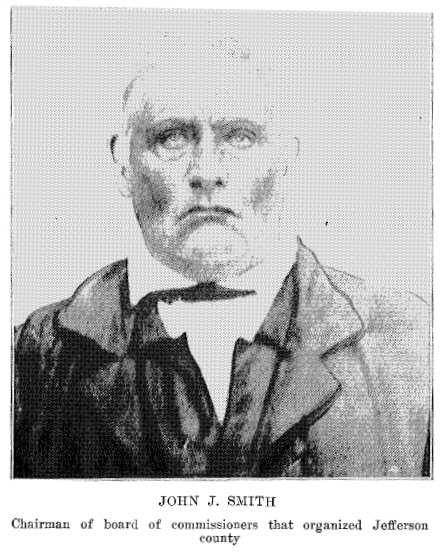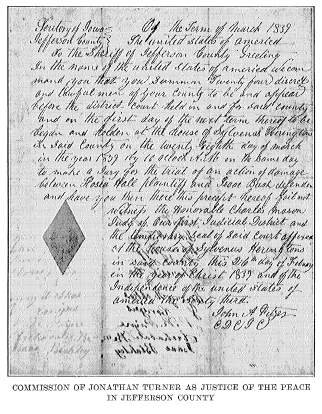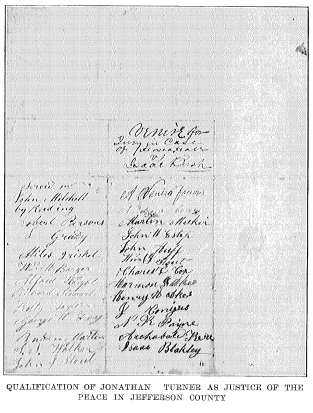 |
Organizing the County |
 |
 |
Organizing the County |
 |
The organization of Jefferson County did not wholly wait upon legislative action. That it was to be favorable was anticipated. To understand this it should be borne in mind that under the organic law the governor appointed judicial officers, justices of the peace, sheriffs and militia officers; that the courts appointed their clerks; and that county and township officers, as commissioners, assessors, treasurers, recorders, surveyors and constables "equal to the number of magistrates" were elected.
On January 18, 1839, three days before he approved the bill establishing the county, Governor Lucas nominated "by and with the advice and consent of the legislative council," to be justices of the peace in Jefferson County, Daniel Sears, Jesse C. Walker, Rodham Bonnifield, Jonathan Turner, Elijah Chastian (sic - Chastain), Josiah Lee, Joseph Parker, Amos Summers, Reuben Root, Enos Ellmaker, John Ankrom, John W. Sullivan and John Priest; to be judge of probate, Henry B. Notson; and to be sheriff, Frederick F. Lyons. On the 19th he nominated the "field officers to the militia." The Second Regiment, First Division, Second Brigade, was to be recruited in the counties of Henry and Jefferson. Samuel Braziltine was named to be colonel, Samuel S. Walker, lieutenant colonel, and Joseph L. Myares, major.
A sidelight is thrown upon the characters of the governor's appointees by a passage in his first message to the Legislature. Addressing the council, he expresses the opinion that "the power of appointing to office is one of the most delicate and responsible character." He then states "distinctly" the principles which shall govern him in exercising this authority. "I shall at all times pay a due respect to recommendations; but cannot conscientiously nominate to office any individual of bad moral character, or that may be addicted to intemperance or gambling, if known to me. These vices are so contaminating in their character, that all public officers in my opinion should be clear of even a suspicion of being addicted to them." No reformer of later times has had a clearer vision of public evils and the way to cure them than had this sturdy old conservative.
The justices of the peace were "as many as the public good and the wants of the people may require." To take acknowledgments to bills of sale and deeds and to celebrate marriages were their chief duties. Their authority was broad and coextensive with the county. The term of service was three years. The sheriff's activities were numerous. He served the processes of the courts, was conservator of the peace, had charge of public buildings, collected taxes and posted notices of elections. His term was two years. The court of probate had "jurisdiction over the estates of testators, or intestates," and sat regularly on the first Monday in every month. The judge's term was three years.
The first judicial district was composed of the counties of Henry, Van Buren, Lee and Des Moines. The County of Jefferson was therefore included in this district as a part of the original County of Henry. The judge assigned was Charles Mason. There were two regular terms of court annually in each county. These terms commenced in Henry County on the first Mondays of April and August, and in Jefferson County on the Thursdays preceding them. The allowance of but three days for the sitting of the court would not indicate a litigious community. John A. Pitzer was appointed clerk. This appointment was made in January or early in February. Probably on account of holding this position he was also commissioned on the 2d of March as "postmaster at Jefferson courthouse." The first proposal was to fix the temporary seat of justice at the house of Archibald Kerr. It was later changed to the house of Sulvenus Herrington. The exact location of this house is now in doubt.
The elective officers were chosen at a special election held on the first Monday in April. At least eight days earlier the sheriff as required had caused "written notices to be put up at three of the most public places in each of the old precincts in said County of Jefferson, stating the time, place and officers to be elected." Samuel Moore the deputy performed this work. There were three such precincts. One voting place was at Lockridge, one was at the house of William Vinson in the Locust Grove, and one at John Lee's in the Pleasant Prairie. The Pleasant Prairie was in the northern part of the present township of Walnut. In the absence of more direct information it may be presumed that the judges and clerks were those who had served in the previous election. These judges were appointed by the commissioners of Henry County. The clerks were appointed by the judges. If the presumption is correct, the judges at Lockridge were Amos Lemons, Lincefield Grady and Benjamin Mount, the clerks, Jesse C. Walker and Joseph Parker; the judges at the Locust Grove were Reuben Root, Jacob Bennett and William Vinson, the clerks William Starton (sic - Stanton?) and William H. King; the judges at the Pleasant Prairie were John Lee, William Pickerel and Hiram Miles. The names of the clerks at the last place are missing from the records. The polls were opened at the hour of 9 o'clock in the morning and closed at 6 o'clock in the afternoon of the same day. Qualified electors were priviliged (sic) to vote at any polling place.
The names of the unsuccessful candidates and the number of votes cast in this election have not been preserved. John J. Smith, Daniel Sears and Benjamin F. Chastian were chosen the county commissioners. It is believed Smith had the largest majority, it is known that Chastian had the smallest. The term of a commissioner was regularly three years. In beginnings, however, the candidate having the highest number of votes served three years, the one having the next highest number two years and the one having the next highest number one year. James Gilmer was chosen assessor; John W. Sullivan, treasurer; John A. Pitzer, recorder and William Bonnifield, surveyor. The terms of assessor and treasurer were each one year; of recorder and surveyor, each two years.
The board of county commissioners, then the big wheel in the machinery of local government, was organized on April 8th in the Town of Lockridge by John J. Smith and Daniel Sears. The third member, Benjamin F. Chastian, was absent. John A. Pitzer was made their clerk and was sworn in by Sears who, as a justice of the peace, was qualified to administer oaths.
The commissioners began their labors with promptitude and decision. At once plans were made to survey and plat the Town of Fairfield and to advertise a public sale of lots. A levy of fifty cents per one hundred dollars was laid on all taxable property. Their own compensation which was fixed by law at $3 a day was reduced to $2 a day. As a practical economy the action deserved commendation.
It would be set aside from the present purpose and unprofitable to follow in detail the business of the board. Such acts as reflect the conditions of the period will be set out in connection with the matters to which they refer.
As there were few funds to meet bills with and the revenue was uncertain, many orders were cautiously issued payable on future dates. Six months was the time commonly taken. These orders were, however, accepted in payment of local taxes, which gave them an immediate value.
On May 1st, Alexander Kirk and Baker Alender were appointed to serve as constables until the general election.
On May 25th, it was "ordered that the liberty side of a dime be the seal of the board." This was to comply with a statute requiring the use of a "common seal" for authentication.
On June 8th, the county was divided into five election precincts.
The Pleasant Prairie precinct embraced township number seventy-three north range nine west and township number seventy-three north range, eight west. John Millen's house was the voting place. William Pickerel, Josiah Lee and John Millen were named as the judges.
The Brush Creek precinct embraced township number seventy-two north range eight west and township number seventy-two north range nine west. David Keltner's house was the voting place. Samuel Berry, John Parsons and Joseph Hickenbottom were names (sic) as the judges.
The Round Prairie precinct embraced township number seventy-one north range eight west and township number seventy-one north, range nine west. James Lanman's house was the voting place. James Gilmer, James Lanman and Samuel S. Walker were named as the judges.
The Cedar Creek precinct embraced township number seventy-one north range ten west and township number seventy-one north range, eleven west. Frederick Fisher's house was the voting place. Joseph S. Robb, Greenup Smith and Frederick Fisher were named as the judges.
The Locust Grove precinct embraced township number seventy-two north range ten west and township number seventy-two north range eleven west. William Vinson's house was the voting place. William Vinson, Reuben Root and John D. Glenn were named as the judges.
Before the election two changes of judges occurred in the Cedar Creek precinct. The entry runs that Greensup Smith was substituted for Winsell. This is an obvious error by the clerk. The names should be in reverse order. David Peebler was assigned to the place of Joseph S. Robb, deceased.
On Monday, August 5th, was held the first regular election of the county. There were nine candidates seeking the position of representative. William G. Coop, who was successful, received 313 votes; H. B. Notson, 195 votes; and J. L. Myers, 136 votes. Votes were also cast for J. S. Rook, W. H. Wallace, Simeon Smead, A. B. Porter, J. B. Lash and Joseph Jeffers. Some of these were residents of Henry County with which Jefferson was then districted.
William Hueston received a certificate of election as county commissioner. On August 19th, he took part with Smith and Sears in the reorganization of the board. Chastian contested his right to the office and served at the next session of the board. The case was submitted to a court of three justices of which each contestant selected one member and these two in turn chose the third member. Chastian's contention seems to have been that he was entitled to serve one complete year. Hueston was seated. He then brought suit against Chastian to recover his expenses in the contest. He secured an award by a jury in a justice's court but lost it on an appeal taken to the district court.
There seems to have been a general political disturbance at this time. John W. Sullivan resigned as treasurer. On September 11th, Willis C. Stone was appointed to the vacancy. John A. Pitzer was removed as clerk of the board of county commissioners. He was succeeded on November 15th by Samuel Shuffleton. An agreement with Cyrus Olney to act as the board's attorney was revoked. A special election was called to be held in December to choose a commissioner in place of William Hueston. The mere statements of these actions appear in the board's minutes without the reasons therefor or any explanations.
On November 28th, the Town of Fairfield was constituted an election precinct. John T. Moberly, L. W. Sanders and William Olney were named as the judges. In listing the judges named for the established precincts, the Cedar Creek precinct is called the Lick Creek precinct.
When the county commissioners met on Monday, January 6, 1840, to organize their board, they were recorded as Daniel Sears, Henry B. Notson and Robert Brown. For some unknown cause, John J. Smith as well as William Hueston had dropped out.
On March 31st, the Blue Point election precinct was established. Its territory was not then fixed, but at a later date was declared to embrace township number seventy-three, north range ten west and township number seventy-three north range, eleven west. John Ruggles, William H. Brown and Valentine Nelson were named as the judges.
On June 1st, the Fairfield precinct was enlarged. Its bounds were described as commencing where the Fairfield branch empties into Cedar Creek, running thence in a direct line to Joel Bradshaw's, thence north to the Indian trace leading from Wapello to Keokuk, thence west to McCleary's branch and following its most western branch until it empties into Cedar Creek, and thence on Cedar Creek to the place of beginning.
On July 8th, the voting place in the Round Prairie precinct was located in the Town of Glasgow. The clerk was instructed to give notice that "a vote of the people will be taken at the next general election to test whether or not the county shall organize into townships." This proposition obtained the popular approval.
The county commissioners on Tuesday, January 5, 1841, were Daniel Sears, Robert Brown and Ezekiel J. Gilham. On that day, under the statutory restrictions, they divided the county into civil townships. They were required to make them of such shape and size as suited the convenience and interests of their citizens, to confer upon each the name preferred by its inhabitants, and to appoint in each the place where the first meeting of its electors should be held.
Township number seventy-one north range eight west was made and called the Round Prairie Township. The meeting place of the electors was fixed at the Town of Glasgow.
Township number seventy-two north range eight west and the east half of township number seventy-two range nine west was made and called the Lockridge Township. The meeting place of the electors was fixed at the house of David Keltner.
Township number seventy-three north range eight west was made and called the Walnut Township. The meeting place of the electors was fixed at the house of John Pheasant.
Township number seventy-one north range nine west was made and called Cedar Township. The meeting place of the electors was fixed at the house of Joseph Parker.
Township number seventy-three north, range nine west, was made and called Penn Township. The meeting place of the electors was fixed at the house of Joseph Dillon.
Township number seventy-one north range ten west was made and called Liberty Township. The meeting place of the electors was fixed at the house of Seaton L. Harness.
The west half of township number seventy-two north range nine west and the east two-thirds of township number seventy-two north range ten west was made and called Fairfield Township. The meeting place of the electors was fixed at the courthouse.
Township number seventy-two north range eleven west and the west one-third of township number seventy-two north range ten west was made and called the Locust Grove Township. The meeting place of the electors was fixed at the house of William Vincent.
Township number seventy-three north range ten west and township number seventy-three north range eleven west was made and called the Blackhawk Township. The meeting place of the electors was fixed at the house of S. Jesse Ruggles.
Township number seventy-one north range eleven west was made and called the Des Moines Township. The meeting place of the electors was fixed at the house of Messrs. Cutting and Gordon.
In each of these several civil townships at the places named a meeting was held on the first Monday in April to elect one township clerk, three trustees, two overseers of the poor, three fence viewers, a sufficient number of supervisors of highways, two constables, one township treasurer and three school inspectors. In some instances trustees and supervisors at least were not chosen, for on July 6th the county commissioners appointed Samuel Frasier and David McKee to act as supervisors in Walnut Township and instructed their clerk to issue warrants to those persons receiving the highest number of votes for those offices in any township where the voters failed to elect.
Local matters affecting the community more or less as a whole were the concern of these officials. Trustees, upon petition, established private roads or cartways, laid such taxes as were authorized by the electors and exercised a general oversight. Clerks recorded the transactions of township meetings, private roads and ear-marks and brands of all cattle, sheep and hogs, and such other marks as any person might wish to have recorded in the township. The last was valuable in proving ownership of these domestic animals since, as they were permitted to run on the open lands, they mingled with others and at times strayed far from the vicinity of home. No two persons in a township were permitted to lay legal claim to the same mark. Fence viewers examined fences and assessed damages in cases of trespassing animals. School inspectors fixed the number of districts, apportioned among them the school and library money appropriated, examined candidates for teaching primary schools in regard to moral character, learning and ability to teach, to those possessing the requisite qualifications issued certificates for one year, and at least twice a year visited each school giving such advice to both teacher and scholars as they deemed proper. After a district was formed, its voters on the first Monday in October elected a moderator, a director and an assessor, designated a site for the schoolhouse, selected the place where the library should be kept, named the librarian, and imposed taxes to care for the various expenses incurred. The duties of these officers require no special mention.
Such was the organization of the county. The essential features of the machinery still remain although some experiments have been tried and some adjustments have been made to meet the needs of changed conditions.





Return to the 1912 History of Jefferson County Contents Page